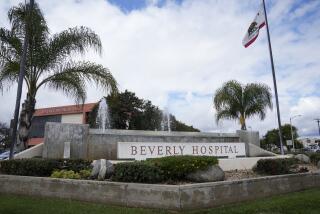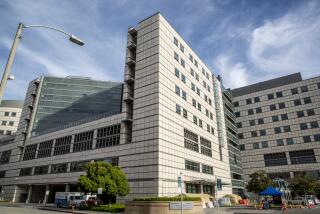Shortage of Beds Is Straining Hospitals
- Share via
After years of empty beds and hospital closures, a growing number of medical centers in California are straining from surging demand and not enough beds to provide sufficient care.
The shortage of hospital beds has caused delays in elective surgery and other admissions, more diversions of patients to other facilities and problems that have added to the backlog in emergency rooms.
Hospitals are responding by installing sophisticated bed-tracking systems, adjusting surgery hours and developing ways to do more procedures on an outpatient basis. Some have converted offices into patient rooms, adding a smattering of beds.
But there are few new hospitals being built in the state. And with a critical shortage of nurses and more hospitals almost certain to be shuttered, many health providers and analysts said the capacity crunch being felt by some will spread and get progressively worse.
Most of the effects so far have been matters of inconvenience rather than life and death, but if the trend continues, experts say it could have an effect on care.
Ian H. Taras, an obstetrician and gynecologist in the San Fernando Valley, said he is scheduling caesarean sections into November because the medical center he uses in Tarzana usually is full.
The most difficult cases, he said, are patients whose needs are between serious and urgent. Earlier this year, when an expectant mother of twins went into pre-term labor, he told her to check into Encino Tarzana Regional Medical Center. But the Tarzana hospital was packed, and Taras and his patient hastily changed plans and went to West Hills Hospital a few miles away
“She was counting on going to Tarzana,” he said.
Orthopedic surgeon Kent Adamson said he is working more successive late-night shifts, waiting for an open operating room at Mission Hospital Regional Medical Center in south Orange County. That’s made his job more stressful.
“It’s doable but not the optimal situation,” he said. “I feel we’re treading and treading pretty hard and succeeding, but how long can you stay afloat?”
Dozens of hospitals, especially smaller ones, still have plenty of unused beds. But statewide, the occupancy rate of available hospital beds--which had remained at the same level during much of the last decade--has risen steadily since 1996 to 64% last year, according to the Office of Statewide Health Planning and Development. Many hospitals are running well above that average, and some are exceeding the 85% rate that experts consider essentially full.
In the last two decades, more than 100 community hospitals have closed in California, according to a July 2001 study by Shattuck Hammond Partners, a consulting firm. The state Department of Health Services said there are about 450 acute-care hospitals in the state.
Many hospitals have collapsed under financial pressure from managed care, cutbacks in Medicare and government reimbursements and what many considered too much competition.
Although hospitals nationwide are running out of beds, in many ways the problem is more critical in California, which has far fewer hospital beds per population than most other states. Yet California’s population is growing much more quickly than the nation as a whole, and for the first time in many years hospital usage and average length of stays are increasing.
The rise in hospital visits and stays is expected to continue, reflecting the loosening of restrictions under managed care, the aging of baby boomers and a higher percentage of critical cases, which some believe is partly the result of delayed care.
Childrens Hospital Los Angeles said it is facing an unprecedented increase in demand for services.
Occupancy at the 314-bed hospital is hovering at close to 80%. The hospital acknowledged that lack of staff and resources has contributed to delays in treatment.
“But these delays are generally hours, not days,” the hospital said, noting that it has not reached a point in which care has been compromised.
At Cedars-Sinai Medical Center, 95% of its 850 available beds were occupied on a recent Friday. The hospital had no flexibility because the few vacant beds were for only pediatric and obstetrics use.
Linda Burnes Bolton, the hospital’s chief nursing officer, said there was a bed for each of the 75 surgeries scheduled for that day. But by early afternoon, five doctors who wanted to admit new patients were told to wait.
“This is a typical Friday,” said Bolton, who meets three times daily with other managers to map out the day’s bedding situation.
Until February, when Cedars-Sinai added surgery on Saturdays and had them go later into the evening on weekdays, the Los Angeles hospital was forced to cancel three or four surgeries a day. Since then, the hospital has not canceled any scheduled operations, Bolton said.
What she and others cannot control are patient visits through the emergency department, which account for four out of 10 admissions at major trauma-center hospitals such as Cedars-Sinai. Overcrowding in emergency rooms has been a burgeoning problem nationwide, with the large number of uninsured patients who typically go to emergency rooms when they have health problems. When emergency arrivals increase, that causes bottlenecks on other floors. But the congestion flows the other way too.
“If the hospital is full, we hold patients in the ER, so everything stops. They can’t go anywhere, so we fill up,” said Dr. Ray Ricci, chairman of the emergency department at Hoag Memorial Hospital Presbyterian in Newport Beach, where the average daily occupancy is close to 90%. “When the hospital is full, the ER is the final sink of the plumbing system.”
Health-care analysts worry that the hospital system in California, and especially in Los Angeles County--which is facing a huge budget shortfall and cutbacks in its medical system--will feel mounting pressure in coming years from capacity constraints.
Many hospital operators in California will not have as much money to build facilities because they are spending hundreds of millions of dollars on meeting seismic retrofitting requirements at existing facilities.
Even if more hospitals could be constructed, many health professionals wonder whether there would be enough nurses to care for the additional patients. Indeed, some said constraint of hospital capacity has as much to do with staffing as it does with space. Hospital officials point out that the state’s mandated nurse-to-patient ratio means they can’t add more beds if they don’t have enough nurses to attend to the patient increase.
Demand, meanwhile, is expected to keep growing.
“It means that most of the existing hospitals will be fuller and fuller and fuller,” said Wanda Jones, president of New Century Healthcare Institute, a research foundation in San Francisco. For years, Jones watched California’s hospital occupancy rise in the winter flu season, drop off in the spring and pick up in the fall. More recently, she said, the pattern of higher bed use has been steadier.
“We’re going to experience a fairly substantial 50-year population growth and a major growth in seniors,” said Jones. “We will have to have additional capacity.”
Sutter Health, a nonprofit operator of 26 hospitals in Northern California, said it will focus mainly on outpatient facilities and bulk up its ambulatory-care departments rather than add beds. Dr. Gordon Hunt, Sutter’s chief medical officer, is betting that advances in medical technology and drugs will significantly reduce the need for beds in the next decade. But he has this caveat:
“It is very hard to plan for future hospital closures,” Hunt said. “We see a lot of hospitals that don’t appear to be stable for the long term.”
Tenet Healthcare Corp., the state’s largest hospital operator, with 43 facilities, this year announced two closures: Daniel Freeman Marina Hospital in Marina del Rey and St. Luke Medical Center in Pasadena, each with about 165 beds. The two hospitals did not meet Tenet’s profitability requirements.
But Tenet also is building a 10-story addition next to its USC University Hospital and adding beds to facilities in Los Alamitos and Redding, Calif., among other places. Hoag Memorial is one of the few independent hospitals that is undertaking a major expansion, including a seven-story women’s health center on its sprawling Newport Beach campus. But it will be four years before an additional 80 beds are ready.
Six months ago, the 414-bed hospital installed a tracking system that automatically signals to admitting staff, housekeeping and nurses when beds are being vacated.
Hoag has asked doctors to make rounds earlier so patients can be discharged earlier in the day.
The hospital staff is developing outpatient protocols for some conditions such as cellulitis, an inflammation of connective tissue, usually in the lower leg. Ricci said Hoag sees 217 patients for cellulitis annually, who spend an average of 4.8 days in the hospital. That would save more than 1,000 patient days each year.
“If we do not have space, we have to make it more efficient,” he said.







